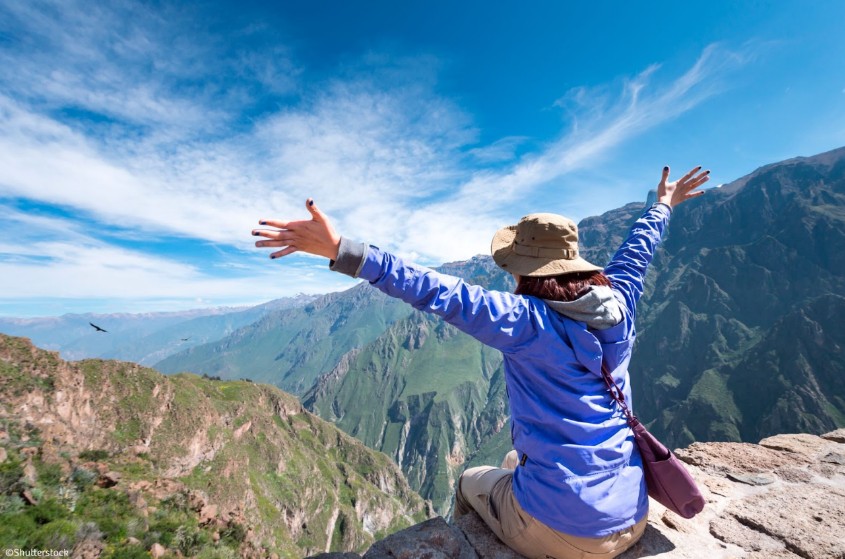The Andean bear, the llama, and the condors are symbols of identity and wildlife that connect travelers with nature and the ancestral history of Peru.
Peru is home to an exceptionally rich biodiversity, where in its skies, mountains, and highlands you can find three emblematic species that fascinate both locals and travelers alike: the condor, the llama, and the Andean bear. In the following lines, you will learn more about where to see them in their natural habitat, why they are so important, and how to contribute to their conservation.
Where to see the Andean condor in full flight?
One of the most breathtaking natural experiences is watching the condor soar over the Andes of Peru. Among the most popular spots is the Colca Canyon, located in the Arequipa region, about 1,009 kilometers from Peru’s capital, Lima. From the “Cruz del Cóndor” viewpoint, where thermal currents allow these birds to glide at sunrise, visitors can witness this magical moment.
The viewpoint sits at around 3,800 meters above sea level and is approximately 173 kilometers from the city of Arequipa. The best times to spot condors are in the early morning and before noon, between May and November, when weather and thermal conditions are most favorable.
Llamas: Everyday companions in the Andes
The llama is an essential part of Peru’s Andean culture. Although domesticated, its natural presence and adaptation to the high-altitude environment make it a familiar sight across many rural areas of the country. In Puno, located 1,402 kilometers from Lima, more than two million camelids can be found, including alpacas, vicuñas, and guanacos.
Just an hour and a half from the city of Cusco, the community of Chinchero offers the chance to see a large number of llamas and alpacas. Known for breeding these camelids, the area allows visitors to observe them up close in different sizes and a wide range of colors.
Awanakancha is a textile center and cultural project dedicated to South American camelids, located just half an hour from the city of Cusco. Here, visitors can meet llamas, alpacas, vicuñas, and guanacos up close, learn about their breeding, and see how their fiber is transformed into fine textiles using ancestral techniques. Local artisans also demonstrate the processes of spinning, dyeing, and weaving live, offering a unique cultural experience that connects nature, tradition, and Andean art.
Spaces like this provide the opportunity not only to see llamas up close but also to understand their role in food, clothing, and Andean culture, while appreciating the ancestral bond that local communities have maintained with them.
Smiling tourist with a llama at Machu Picchu / ©Shutterstock

Andean Bear: The “Ukumari” and its silent presence
The Andean bear, also called the spectacled bear or “Ukumari,” is one of the most iconic and unique animals in South America, and Peru is among the best places to see it in its natural habitat.
According to data from the National Forestry and Wildlife Service (SERFOR), an estimated 5,750 individuals live across different regions of the country. You can spot them in the Amazonian forests of Puno, in southern Peru, particularly in the districts of Ollachea and San Gaban in the province of Carabaya.
They can also be observed in cloud Amazon areas of northern Piura and, most notably, within the Historic Sanctuary of Machupicchu in the Cusco region. Watching this majestic mammal—considered a symbol of Andean biodiversity—is a one-of-a-kind experience for travelers seeking a deeper connection with nature during their journey through Peru.

Andean Bear / ©Shutterstock
What tips should you follow to experience these species responsibly?
- Join tours with authorized local guides to respect natural habitats and minimize disruption.
- Visit early in the morning to watch condors taking advantage of thermal currents.
- Keep a safe distance from wildlife; do not feed them or get too close for photos.
- Explore only in regulated protected areas; obtain permits and purchase official tickets when required.
Exploring the Andes and the highlands of Peru means encountering living symbols of nature and culture. Seeing a condor soar across a canyon, a llama grazing on the puna, or an Andean bear roaming its forest is more than a photograph—it is about connection, respect, and conservation.

